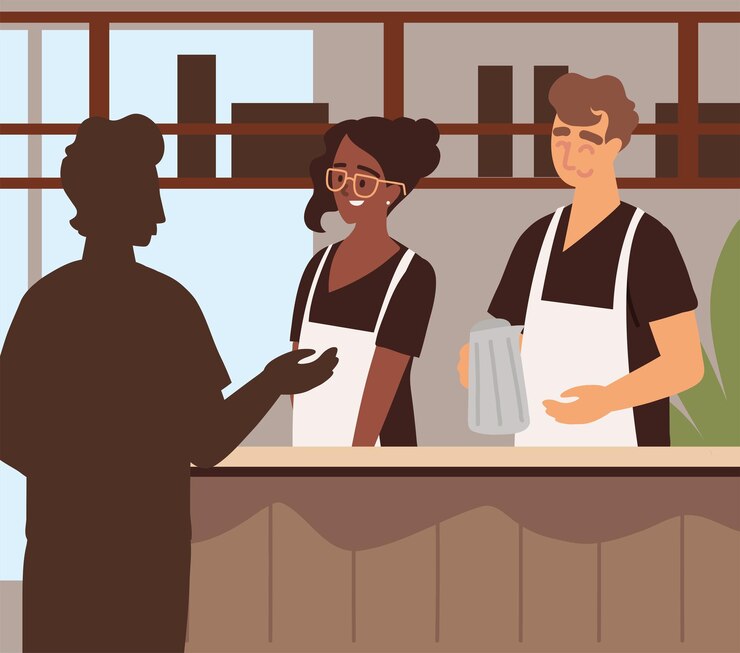Opening a restaurant is the dream of many aspiring entrepreneurs. When managed correctly, they can be profitable and fulfilling ventures. They allow you to connect with your community and enjoy financial success. Whether embracing a traditional restaurant experience or experimenting with new food trends, there are countless ways to make your dream a reality. Nevertheless, starting a restaurant requires careful planning and thoughtful execution. We’ve created a step-by-step guide walking you through the restaurant startup process so that you can position your new business for success.
Step 1: Choose a Restaurant Concept
The first step in creating your cafe business plan is to choose a restaurant concept. This concept will guide all other aspects of your business. It includes the type of food you will serve, the atmosphere you want to create, and your target customer base. Do you want a cozy cafe with homemade pastries? Or maybe a trendy spot with artisanal coffee? Your concept should reflect your passion and vision.
Step 2: Write a Restaurant Business Plan
Writing a restaurant business plan is crucial. This document outlines your business goals, strategies, and financial projections. It serves as a roadmap for your cafe and helps secure funding from investors. Your business plan should include sections on your restaurant concept, market analysis, marketing strategy, and financial projections. For a detailed guide on writing a business plan, visit this link.
Step 3: Obtain Restaurant Funding
Next, you need to secure funding for your cafe. There are several options available, including personal savings, bank loans, and investors. It’s essential to have a clear understanding of how much money you need and how you plan to use it. This will help you present a compelling case to potential investors and lenders.
Step 4: Create a Menu
Your menu is a critical part of your cafe business plan. It should reflect your restaurant concept and appeal to your target customers. When creating your menu, consider factors such as ingredient costs, preparation time, and dietary restrictions. A well-thought-out menu can set your cafe apart from the competition and attract loyal customers.
Step 5: Find a Commercial Space
Finding the right location is crucial for your cafe’s success. Look for a commercial space that is easily accessible, has good foot traffic, and fits your restaurant concept. Consider factors such as rent, lease terms, and the condition of the property. A prime location can significantly impact your cafe’s visibility and customer base.
Step 6: Plan Your Restaurant’s Layout
Once you have secured a location, it’s time to plan your restaurant’s layout. This includes the dining area, kitchen, storage, and restrooms. Your layout should maximize efficiency and create a comfortable atmosphere for your customers. Consider hiring a professional designer to help you create an inviting and functional space.
Step 7: Acquire Restaurant Permits and Licenses
Before you can open your cafe, you need to obtain the necessary permits and licenses. These may include health permits, food handler permits, and business licenses. The requirements vary by location, so it’s essential to research the regulations in your area. Ensuring you have all the necessary permits and licenses will help you avoid legal issues and fines.
Step 8: Acquire Restaurant Equipment
Next, you need to purchase the equipment for your cafe. This includes kitchen appliances, furniture, and utensils. When selecting equipment, consider factors such as quality, durability, and cost. Investing in high-quality equipment can save you money in the long run and ensure your cafe runs smoothly.
Step 9: Hire Restaurant Staff
Your staff plays a crucial role in the success of your cafe. Hire employees who are passionate about food and customer service. Provide comprehensive training to ensure they understand your restaurant concept and can deliver a consistent experience. A dedicated and well-trained staff can enhance your cafe’s reputation and customer satisfaction.
Step 10: Advertise Your Restaurant
Marketing is essential for attracting customers to your cafe. Use a mix of online and offline marketing strategies to reach your target audience. This may include social media, email marketing, local advertising, and promotions. A strong marketing plan can help you build brand awareness and attract loyal customers.
Step 11: Host a Soft Opening
Before your grand opening, consider hosting a soft opening. This is a smaller event where you invite friends, family, and local influencers to experience your cafe. A soft opening allows you to gather feedback and make any necessary adjustments. It also creates buzz and anticipation for your official opening.
Frequently Asked Questions
What Are The Key Components Of A Cafe Business Plan?
A cafe business plan should include an executive summary, market analysis, marketing strategy, operations plan, and financial projections.
How Do You Write A Cafe Business Plan?
Start with a clear concept, conduct market research, outline your marketing strategy, plan operations, and detail financial projections.
What Is A Cafe Market Analysis?
A cafe market analysis involves researching your target audience, competitors, market size, and trends to understand your business environment.
How To Create A Cafe Marketing Strategy?
Identify your target market, set goals, choose marketing channels, and create campaigns to attract and retain customers.
What Permits Do I Need To Open A Cafe?
You typically need health permits, food handler permits, business licenses, and possibly alcohol licenses, depending on your location.
How To Choose A Location For A Cafe?
Consider foot traffic, visibility, competition, and proximity to your target market to select the best location for your cafe.
Conclusion
Make a Cafe Business Plan. By following these steps and creating a detailed cafe business plan, you can set your new venture up for success. Remember to stay passionate, be patient, and enjoy the process. For more information on starting a restaurant, visit this link.









